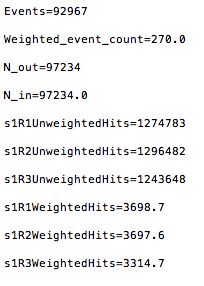Difference between revisions of "Weighted Occupancy"
Jump to navigation
Jump to search
CLAS12 Occupancy
Occupancy(50nA)=
Occupancy(75nA)=
Occupancy(100nA)=
Occupancy(50nA)=
Occupancy(75nA)=
Occupancy(100nA)=
CLAS12 Occupancy
Occupancy(50nA)=
Occupancy(75nA)=
Occupancy(100nA)=
Occupancy(50nA)=
Occupancy(75nA)=
Occupancy(100nA)=
| Line 44: | Line 44: | ||
<center>Occupancy(100nA)=<math>\frac{3698.7}{270}\frac{1.56E-7}{250E-9}\frac{1}{112}\frac{100}{12}=0.637\%</math></center> | <center>Occupancy(100nA)=<math>\frac{3698.7}{270}\frac{1.56E-7}{250E-9}\frac{1}{112}\frac{100}{12}=0.637\%</math></center> | ||
| + | |||
| + | |||
| + | If 250ns is the time limit, then solving the time of simulation backwards will give the number of incident electrons within that window. | ||
| + | |||
| + | <center><math>t_{sim}(50nA)=\frac{N_{in}}{\frac{50E-9\ A}{}\frac{1\ C}{1\ A}\frac{}{1\ s}\frac{1\ e^{-}}{1.602E-19\ C}}=\frac{N_{in}}{312,109,862,672\ e^{-}/s}=250E-9\ s\rightarrow N_{in}=78027.5\ e^{-}</math></center> | ||
| + | |||
| + | |||
| + | <center><math>t_{sim}(75nA)=\frac{N_{in}}{\frac{50E-9\ A}{}\frac{1\ C}{1\ A}\frac{}{1\ s}\frac{1\ e^{-}}{1.602E-19\ C}}=\frac{N_{in}}{468,164,794,007\ e^{-}/s}=250E-9\ s\rightarrow N_{in}=117041.2\ e^{-}</math></center> | ||
| + | |||
| + | |||
| + | <center><math>t_{sim}(100nA)=\frac{N_{in}}{\frac{50E-9\ A}{}\frac{1\ C}{1\ A}\frac{}{1\ s}\frac{1\ e^{-}}{1.602E-19\ C}}=\frac{N_{in}}{624,219,725,343\ e^{-}/s}=250E-9\ s\rightarrow N_{in}=156054.9\ e^{-}</math></center> | ||
| + | |||
==Method 2== | ==Method 2== | ||
Revision as of 04:29, 25 July 2018
Total XSect=0.013866
97234 incident electrons
Method 1
Using the unweighted amounts
Using the weighted amounts
If 250ns is the time limit, then solving the time of simulation backwards will give the number of incident electrons within that window.
Method 2
Using the unweighted amounts
Using the weighted amounts
